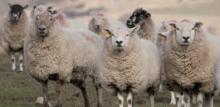These are now regarded as different stages of the same disease, both caused by Dichelobacter nodosus.
It is the most common cause of lameness on a majority of farms.
Treatment
Do not trim - only 5-10% of trimmed feet cured, compared to 95% of those treated with injectable antibiotics (trimming as well as injection halved the number that recovered). Therefore, aim to catch and inspect all lame sheep within 3 days, treat Footrot/scald with injectable oxytetracycline and oxytetracycline spray.
Control
Prompt treatment of lame sheep reduces the infection of others. Isolating individual sheep with foot rot, when housed as well as grazing, also limits spread. At weaning, separate out all lame ewes so attention can be focused on them, if they do not recover fully before the rams go in they should be culled.
Culling of persistent offenders is important in the early stages of control, but this should reduce to a very small number once the problem is under control. Vaccination provides protection for 4-6 months and is useful in preventing outbreaks, but it is important to be sure that Footrot is the main cause of lameness before using it.
Foot bathing can be useful in treating outbreaks of scald, but is ineffective for severe Footrot as it kills bacteria on the surface of the hoof only. Sheep must stand on concrete for 30minutes before and after footbathing.
When buying in new sheep, quarantine them for at least 3 weeks; different strains of Footrot can be introduced as well as new diseases such as CODD.
Some farms get a noticeable outbreak in spring, particularly of scald in lambs. This is caused by warm and wet conditions plus having lots of lambs that have no immunity to it and closer contact between sheep. To minimise this outbreak, treat ewes promptly if they are lame pre-lambing and don’t turn out with rest of flock to decrease the infection levels on pasture.
Routine trimming
- Essentially a waste of time and may be harmful
- Associated with more Footrot, more CODD and more lameness
- Can cause toe granuloma, which are very hard to treat, often end up culling affected sheep
For more information have a look at this fact sheet - sheep lameness, or the AHDB booklet - Reducing Lameness for Better Returns. Alternatively, call the practice and speak to a member of the farm team - 01363 772860.


